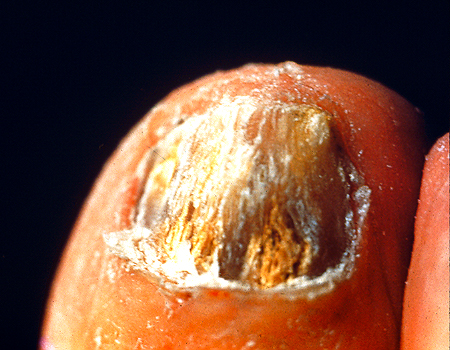
|  |

 |
|
|

|
What are they?
Not all discolored,
thickened, or deformed nail plates are due to fungus infections. Indeed,
many are due to trauma, congenital (birth) changes and other conditions such
as drug use, high fever ailments and
 circulatory
problems. The actual fungus nail itself is one that is diagnosed through
clinical cultures and identification of the involved organism. It is usually
a thickened and yellowish-brown discolored nail plate surface. In most
cases, the infection starts at the end of the toenail and progressively
involves the remainder of the plate. The vast majority of fungus nails are
asymptomatic or painless and for many, are more of a cosmetic problem than
anything else. Most authorities agree that fungus nails are not contagious
between people but a progressive involvement from one toe to another is
still a confusing issue for many. circulatory
problems. The actual fungus nail itself is one that is diagnosed through
clinical cultures and identification of the involved organism. It is usually
a thickened and yellowish-brown discolored nail plate surface. In most
cases, the infection starts at the end of the toenail and progressively
involves the remainder of the plate. The vast majority of fungus nails are
asymptomatic or painless and for many, are more of a cosmetic problem than
anything else. Most authorities agree that fungus nails are not contagious
between people but a progressive involvement from one toe to another is
still a confusing issue for many.
How do you treat them?
The treatment methods available
for fungus nails are about as numerous as are the varieties of nails
themselves. Oral medications are available but their use is expensive, long
term and not without potential hazardous changes to the blood. Before
starting oral medications for fungused nails one should have a nail culture
to make sure it is fungus we are trying to treat. Laboratory tests to
determine liver profiles should be taken prior to starting the medication
and again at 6 weeks. Localized reduction and periodic care of the nails are
purely temporary and resemble the use of Kleenex in treating the common
cold. Although beneficial on a limited scale, this form of treatment is
geared toward preventing the condition from worsening. Various types of
topical medications are available both over the counter and by prescription,
which can be effective. Many patients prefer the use of a topical medication
over an oral or systemic drug.
An additional method of
treatment that is frequently used is to surgically remove the involved nail
plate and treat the underlying fungus infection on the nail bed area. Once
the hardened plate is removed, the open exposure allows more effective
penetration by topical products and medications. Other methods of treatment,
less frequently used, are also available. In short, numerous treatment
methods are available for the approach to fungus nails. A primary evaluation
and decision must be made as to how serious the problem is to the patient.
Whether to treat aggressively or periodically observe the condition are
viable considerations for the patient. Fungus nails are frequently
perplexing and persistent conditions both from a diagnostic and then a
therapeutic standpoint. Perhaps, in the near future, more effective
medication will become available which will facilitate the management of
this problem.
|